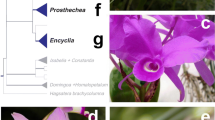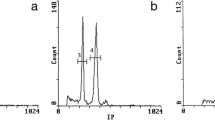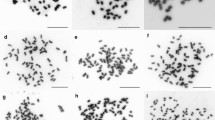Abstract
Lippia alba is a phenotypically variable tropical shrub thought to comprise a young autopolyploid complex. Chromosome numbers in L. alba include 2n = 30, 38, 45, 60, and 90. High levels of chemical and phenotypic variation associated with economic and medicinal importance were reported. However, the genetic background including chromosome composition remains under-explored. Furthermore, the occurrence of at least four ploidal levels in L. alba and the lack of data for polyploid plants in tropical areas also merit further study of L. alba. Here we assessed the chromosome composition using two new satellite repeats (CL98 and CL66) applied as FISH probes to mitotic chromosomes, and we proposed to calculate the degree of homozygosis for CL66 satDNA (named as index h) and to associate it to meiotic instability. The CL98 mapping showed few variations in both number of signals and position. However, the levels of structural homozygosity for a satellite repeat CL66 were very variable. The numbers of CL66-bearing-chromosomes were under-represented in tetraploids relative to diploids implying that CL66 arrays have been lost in tetraploid lineages as a result of increased meiotic instability. High percentage of irregularities was observed in meiotic cells, especially in polyploids. L. alba complex comprised a mixture of homomorphic and heteromorphic chromosomes. Overall, the polyploid complex presents features typical of both young and older stable polyploids. It seems that L. alba genome is still in the process of stabilization.





Similar content being viewed by others
References
Ambrožová K, Mandáková T, Bureš P, Neumann P, Leitch IJ, Koblížková A, Macas J, Lysak MA (2011) Diverse retrotransposon families and an AT-rich satellite DNA revealed in giant genomes of Fritillaria lilies. Ann Bot 107:255–268
Barker MS, Arrigo N, Baniaga AE, Li Z, Levin DA (2016) On the relative abundance of autopolyploids and allopolyploids. New Phytol 210:391–398
Belyayev A, Paštová L, Fehrer J, Josefiová J, Chrtek J, Mráz P (2018) Mapping of Hieracium (Asteraceae) chromosomes with genus-specific satDNA elements derived from next-generation sequencing data. Plant Syst Evol 304:387–396
Biscotti MA, Canapa A, Forconi M, Olmo E, Barucca M (2015) Transcription of tandemly repetitive DNA: functional roles. Chromosom Res 23:463–477
Bolger AM, Lohse M, Usadel B (2014) Trimmomatic: a flexible trimmer for Illumina Sequence Data. BMC Bioinform 30:2114–2120
Buggs RJA, Renny-Byfield S, Chester M, Jordon-Thaden IE, Viccini LF, Chamala S, Leitch AR, Schnable PS, Barbazuk WB, Soltis PS, Soltis DE (2012) Next-generation sequencing and genome evolution in allopolyploids. Am J Bot 99:372–382
Campos JMS, Sousa SM, Silva PS, Pinheiro LC, Sampaio F, Viccini LF (2011) Chromosome numbers and DNA C values in the genus Lippia (Verbenaceae). Plant Syst Evol 291:133–140
Carvalho CR, Saraiva LS (1993) A new heterochromatin banding pattern revealed by modified HKG banding technique for maize chromosomes. Heredity 70:515–519
Čertner M, Fenclova E, Kúr P et al (2017) Evolutionary dynamics of mixed-ploidy populations in an annual herb: dispersal, local persistence and recurrent origins of polyploids. Ann Bot 120:303–315
Chester M, Lipman LJ, Gallagher JP, Soltis SP, Soltis DE (2013) An assessment of karyotype restructuring in the neoallotetraploid Tragopogon miscellus (Asteraceae). Chromosom Res 21:75–85
Dai X, Li X, Huang Y, Liu X (2020) The speciation and adaptation of the polyploids: a case study of the Chinese Isoetes L. diploid-polyploid complex. BMC Evol Biol 20:118
Dodsworth S, Chase MW, Leitch AR (2016) Is post-polyploidization diploidization the key to the evolutionary success of angiosperms? Bot J Linn Soc 180:1–5
Doležel J, Binarova P, Lucretti S (1989) Analysis of nuclear DNA content in plant cells by flow cytometry. Biol Plant 31:113–120
Doyle JJ, Coate JE (2019) Polyploidy, the nucleotype, and novelty: the impact of genome doubling on the biology of the cell. Int J Plant Sci 180:1–52
Doyle JJ, Doyle JL (1987) A rapid DNA isolation procedure for small quantities of fresh leaf tissue. Phytochem Bull 19:11–15
Duchoslav M, Safárová L, Krahulec F (2010) Complex distribution patterns, ecology and coexistence of ploidy levels of Allium oleraceum (Alliaceae) in the Czech Republic. Ann Bot 105:719–735
Emadzade K, Jang TS, Macas J, Kovařík A, Novák P, Parker J, Weiss-Schneeweiss H (2014) Differential amplification of satellite PaB6 in chromosomally hypervariable Prospero autumnale complex (Hyacinthaceae). Ann Bot 114:1597–1608
Gaeta RT, Pires J (2010) Homoeologous recombination in allopolyploids: the polyploid ratchet. New Phytol 186:18–28
Galbraith DW, Harkins KR, Maddon JM, Ayres NM, Sharma DP, Firoozabady E (1983) Rapid flow cytometric analysis of the cell-cycle in intact plant-tissues. Science 220:1049–1051
Garrido-Ramos MA (2015) Satellite DNA in Plants: more than just rubbish. Cytogenet Genome Res 146:153–170
Hegarty M, Coate J, Sherman-Broyles S, Abbott R, Hiscock S, Doyle J (2013) Lessons from natural and artificial polyploids in higher plants. Cytogenet Genome Res 140:204–225
Heitkam T, Petrasch S, Zakrzewski F, Kögler A, Wenke T, Wanke S, Schmidt T (2015) Next-generation sequencing reveals differentially amplified tandem repeats as a major genome component of Northern Europe’s oldest Camellia japonica. Chromosom Res 23:791–806
Henebelle T, Sahpaz S, Joseph H, Bailleul F (2008) Ethnopharmacology of Lippia alba. J Ethnopharmacol 116:211–222
Heslop-Harrison JS, Heslop-Harrison Y (1970) Evaluation of pollen viability by enzymatically induced fluorescence; intracellular hydrolysis of fluorescein diacetate. Stain Technol 45:115–120
http://www.splink.org.br. Accessed 16 September 2020
Husband BC, Schemske DW (2000) Ecological mechanisms of reproductive isolation between diploid and tetraploid Chamerion angustifolium. J Ecol 88:689–701
Jang T-S, Parker JS, Emadzade K, Temsch EM, Leitch AR, Weiss-Schneeweiss H (2018) Multiple origins and nested cycles of hybridization result in high tetraploid diversity in the Monocot Prospero. Front Plant Sci 9:433
Jiao Y, Wickett NJ, Ayyampalayam S, Chanderbali AS, Landherr L, Ralph PE, Tomsho LP, Hu Y, Liang H, Soltis PS, Soltis DE, Clifton SW, Schlarbaum SE, Schuster SC, Ma H, Leebens-Mack J, dePamphilis CW (2011) Ancestral polyploidy in seed plants and angiosperms. Nature 473:97–100
Joachimiak AJ, Hasterok R, Sliwinska E, Musiał K, Grabowska-Joachimiak A (2018) FISH-aimed karyotype analysis in Aconitum subgen. Aconitum reveals excessive rDNA sites in tetraploid taxa. Protoplasma 255:1363–1372
Julião SA, Ribeiro CV, Lopes JML, Matos EM, Reis AC, Peixoto PHP, Machado MA, Azevedo ALS, Grazul RM, Campos JMS, Viccini LF (2020) Induction of synthetic polyploids and assessment of genomic stability in Lippia alba. Front Plant Sci 11:292. https://doi.org/10.3389/fpls.2020.00292
Kato A, Lamb JC, Albert PS, Danilova T, Han F, Gao Z, Findley S, Birchler JA (2011) Chromosome painting for plant biotechnology. In: Birchler JA (ed) Plant chromosome engineering: methods and protocols. Humana Press, Totowa, pp 67–96
Kolář F, Čertner M, Suda J, Schönswetter P, Husband BC (2017) Mixedploidy species: progress and opportunities in polyploid research. Trends Plant Sci 22:1041–1055
Koukalova B, Moraes AP, Renny-Byfield S, Matyasek R, Leitch AR, Kovarik A (2010) Fall and rise of satellite repeats in allopolyploids of Nicotiana over c. 5 million years. New Phytol 186:148–160
Krejčíková J, Sudová R, Oberlander K, Dreyer L, Suda J (2013) The spatio-ecological segregation of different cytotypes of Oxalis obtusa (Oxalidaceae) in contact zones. S Afr J Bot 88:62–68
Kubis S, Schmidt T, Heslop-Harrison JS (1998) Repetitive DNA elements as a major component of plant genomes. Ann Bot 82:45–55
Landis JB, Soltis DE, Li Z, Marx HE, Barker MS, Tank DC, Soltis PS (2018) Impact of whole-genome duplication events on diversification rates in angiosperms. Am J Bot 105:1–16
Leitch IJ, Bennett MD (2004) Genome downsizing in polyploid plants. Bot J Linn Soc 82:651–663
Levin DA (2021) Propagule pressure and the establishment of emergent polyploid populations. Ann Bot 127:1–5
Lim KY, Kovarik A, Matyasek R, Chase MW, Knapp S, Mccarthy E, Clarkson JJ, Leitch AR (2006) Comparative genomics and repetitive sequence divergence in the species of diploid Nicotiana section Alatae. Plant J 48:907–919
Lim KY, Matyasek R, Kovarik A, Fulnecek J, Leitch AR (2005) Molecular cytogenetics and tandem repeat sequence evolution in the allopolyploid Nicotiana rustica compared with diploid progenitors N. paniculata and N. undulata. Cytogenet Genome Res 109:298–309
Lopes JML, Carvalho HH, Zorzatto C, Azevedo AL, Machado MA, Salimena FRG et al (2020) Genetic relationships and polyploid origins in the Lippia alba complex. Am J Bot 107:1–11
Mandáková T, Lysak MA (2018) Post-polyploid diploidization and diversification through dysploid changes. Curr Opin Plant Biol 42:55–65
Mandáková T, Mummenhoff K, Al-Shehbaz IA, Mucina L, Mühlhausen A, Lysak MA (2012) Whole-genome triplication and species radiation in the southern African tribe Heliophileae (Brassicaceae). Taxon 61:989–1000
McAllister C, Blaine R, Kron P, Bennett B, Garrett H, Kidson J, Matzenbacher B, Glotzbach A, Miller AJ (2015) Environmental correlates of cytotype distribution in Andropogon gerardii (Poaceae). Am J Bot 102:92–102
Norrmann GA, Keeler KH (2003) Cytotypes of Andropogon gerardii Vitman (Poaceae): fertility and reproduction of aneuploids. Bot J Linn Soc 141:95–103
Novak P, Neumann P, Macas J (2010) Graph-based clustering and characterization of repetitive sequences in next-generation sequencing data. BMC Bioinform 11:378
Padilla-García N, Rojas-Andrés BM, López-González N, Castro M, Castro S, Loureiro J, Albach DC, Machon N, Martínez-Ortega MM (2018) The challenge of species delimitation in the diploid-polyploid complex Veronica subsection Pentasepalae. Mol Phylogenet Evol 119:196–209
Pezer Ž, Brajković J, Feliciello I, Ugarković Ð (2012) Satellite DNA-mediated effects on genome regulation. In: Garrido-Ramos MA eds. Repetitive DNA. Genome Dyn 7: 153–169
Pierre PMO, Sousa SM, Davide LC, Machado MA, Viccini LF (2011) Karyotype analysis, DNA content and molecular screening in Lippia alba (Verbenaceae). An Acad Bras Ciênc 83:993–1005
Plohl M, Luchetti A, Mestrovic N, Mantovani B (2008) Satellite DNAs between selfishness and functionality: structure, genomics and evolution of tandem repeats in centromeric (hetero) chromatin. Gene 409:72–82
Plohl M, Meštrović N, Mravinac B (2012) Satellite DNA evolution. In: Garrido-Ramos MA eds. Repetitive DNA. Genome Dyn 7: 126–152
Ramsey J, Schemske DW (1998) Pathways, mechanisms, and rates of polyploid formation in flowering plants. Annu Rev Ecol Evol Syst 29:467–501
Ramsey J, Schemske DW (2002) Neopolyploidy in flowering plants. Annu Rev Ecol Evol Syst 33:589–639
Reis AC, Sousa SM, Vale AA, Pierre PMO, Franco AL, Campos JMS, Vieira RF, Viccini LF (2014) Lippia alba (Verbenaceae): a new tropical autopolyploid complex? Am J Bot 101:1002–1012
Reis AC, Sousa SM, Viccini LF (2016) High frequency of cytomixis observed at zygotene in tetraploid Lippia alba. Plant Syst Evol 302:121–127
Rice A, Šmarda P, Novosolov M, Drori M, Glick L, Sabath N, Meiri S, Belmaker J, Mayrose I (2019) The global biogeography of polyploid plants. Nat Ecol Evol 3:265–273
Rojas-Andrés BM, Padilla-García N, de Pedro M et al (2019) Environmental differences are correlated with the distribution pattern of cytotypes in Veronica subsection Pentasepalae at a broad scale. Ann Bot 125:471–484
Rosato M, Galián JA, Rosselló JA (2012) Amplification, contraction and genomic spread of a satellite DNA family (E180) in Medicago (Fabaceae) and allied genera. Ann Bot 109:773–782
Sanders RW (2001) The genera of Verbenaceae in the southeastern United States. Harv Pap Bot 5:303–358
Schinkel CCF, Kirchheimer B, Dullinger S, Geelen D, de Storme N, Hörandl E (2017) Pathways to polyploidy: indications of a female triploid bridge in the alpine species Ranunculus kuepferi (Ranunculaceae). Plant Syst Evol 303:1093–1108
Sharma S, Raina SN (2005) Organization and evolution of highly repeated satellite DNA sequences in plant chromosomes. Cytogenet Genome Res 109:15–26
Simonin KA, Roddy AB (2018) Genome downsizing, physiological novelty, and the global dominance of flowering plants. PLoS Biol 16:e2003706
Soltis DE, Visger CJ, Marchant DB, Soltis PS (2016) Polyploidy: pitfalls and paths to a paradigm. Am J Bot 103:1146–1166
Sousa SM, Silva PS, Torres GA, Viccini LF (2009) Chromosome banding and essential oils composition of Brazilian accessions of Lippia alba (Verbenaceae). Biologia 64:711–715
Spoelhof JP, Chester M, Rodriguez R, Geraci B, Heo K, Mavrodiev E, Soltis PS, Soltis DE (2017) Karyotypic variation and pollen stainability in resynthesized allopolyploids Tragopogon miscellus and T. mirus. Am J Bot 104:1484–1492
Tayalé A, Parisod C (2013) Natural pathways to polyploidy in plants and consequences for genome reorganization. Cytogenet Genome Res 140:79–96
Torres GA, Gong Z, Iovene M, Hirsch CD, Buell CR, Bryan GJ, Novák P, Macas J, Jiang J (2011) Organization and evolution of subtelomeric satellite repeats in the potato genome. G3-Genes Genom Genet 1:85–92
Torres E, Lopez N (2007) Phenotypic plasticity of Lippia alba and Lippia origanoides (Verbenaceae) in response to availability of light. Acta Biolo Colomb 12:91–102
Ugarković D (2005) Functional elements residing within satellite DNAs. EMBO Rep 6:1035–1039
Van de Peer Y, Mizrachi E, Marchal K (2017) The evolutionary significance of polyploidy. Nat Rev Genet 18:411–424
Venâncio DFA, Viccini LF, Luizi-Ponzo AP, Prezoto F (2016) Flower-visiting insects and phenology of Lippia alba (Lamiales: Verbenaceae): floral color changes and environmental conditions as cues for pollinators. Environ Entomol 45:685–693
Viccini LF, Pierre PMO, Praça MM, Souza da Costa DC, Romanel-Costa, Souza SM, Pereira-Peixoto PH, Salimena FR (2006) Chromossome number in the genus Lippia (Verbenaceae). Plant Syst Evol 256:171–178
Viccini LF, Silveira RS, Do Vale AA, Campos JMS, Reis AC, Oliveira MS, Campos VR, Carpanez AG, Grazul RM (2014) Citral and linalool content has been correlated to DNA content in Lippia alba (Mill.) N.E. Brown (Verbenaceae). Ind Crop Prod 59:14–19
Wang J, Qin J, Sun P, Ma X, Yu J, Li Y, Sun S, Lei T, Meng F, Wei C, Li X, Guo H, Liu X, Xia R, Wang L, Ge W, Song X, Zhang L, Guo D, Wang J, Bao S, Jiang S, Feng Y, Li X, Paterson AH, Wang X (2019) Polyploidy index and its implications for the evolution of polyploids. Front Genet 10:807
Zhao Y, Feng Y, Liu R, Duo Q (2017) Isolation and characterization of chromosomal markers in Poa pratensis. Mol Cytogenet 10:1–9
Zhao X, Si Y, Hanson RE, Crane CF, Price HJ, Stelly DM, Wendel JF, Paterson AW (1998) Dispersed repetitive DNA has spread to new genomes since polyploid formation in cotton. Genome Res 8:479–492
Funding
This work was supported by CNPq (432412/2016-6 and 313740/2017-8), FAPEMIG, and CAPES.
Author information
Authors and Affiliations
Corresponding author
Ethics declarations
Conflict of interest
The authors declare no competing interests.
Additional information
Handling Editor: Sergey Mursalimov
Publisher’s note
Springer Nature remains neutral with regard to jurisdictional claims in published maps and institutional affiliations.
Supplementary information
Fig. S1
Circular graph layouts of CL98 (A) and CL66 (B) clusters. (PNG 104 kb)
Fig. S2
representative meiocytes in different meiosis stages. On the left, DAPI fluorochrome staining and on the right, CL66 probing stained with texas red fluorochrome. a) haploid microspore with 15 chromosomes and five CL66 sites (2x, BGEN-29); b) cytomixis process between meiocytes with unequal distribution of CL 66 sites (4x, BGEN-92); c) prophase I with pairing errs, multivalents (4x, BGEN-03); d) metaphase I with chromosome losses (3x, BGEN-01); e) telophase II with lost chromosomes and unequal segregation of CL 66 sites (4x, BGEN-61); f) triad with unbalanced CL 66 sites (3x, BGEN-59); g-h) polyad with unequal distribution of chromosomes and CL 66 sites at the final of the division (6x, BGEN-42; 4x BGEN-92, respectively). Bar = 5 μm. (PNG 5855 kb)
Fig. S3
Representative karyograms of Lippia alba (2n = 2x = 30) showing ten CL66-bearing chromosomes (red signals) and the proportion of homomorphic pairs (h-index) for each accession assessed. (PNG 511 kb)
Fig. S4
Representative karyograms of Lippia alba (2n = 2x = 30) showing 11 CL66-bearing chromosomes (red signals) and the proportion of homomorphic pairs (h-index) for each accession assessed. (PNG 326 kb)
Fig. S5
Representative karyograms of Lippia alba (2n = 2x = 30) showing 12 CL66-bearing chromosomes (red signals) and the proportion of homomorphic pairs (h-index) for each accession assessed. (PNG 287 kb)

Fig. S6
Representatives karyograms of Lippia alba (2n = 2x = 30) showing 13, 14 and15 CL66-bearing chromosomes (red signals) and the proportion of homomorphic pairs (h-index) for each accession assessed. (PNG 427 kb)
Fig. S7
Representative karyograms of Lippia alba (2n = 2x = 30) showing 16 and18 CL66-bearing chromosomes (red signals) and the proportion of homomorphic pairs (h-index) for each accession assessed. (PNG 394 kb)
Fig. S8
Representative karyograms of Lippia alba (2n = 3x = 45) showing 16, and 21CL66-bearing chromosomes (red signals) and the proportion of homomorphic pairs (h-index) for each accession assessed. (PNG 566 kb)
Fig. S9
Representative karyograms of Lippia alba (2n = 3x = 45) showing 23 CL66-bearing chromosomes (red signals) and the proportion of homomorphic pairs (h-index) for each accession assessed. (PNG 403 kb)
Fig. S10
Representative karyograms of Lippia alba (2n = 4x = 60) showing ten CL66-bearing chromosomes (red signals) and the proportion of homomorphic pairs (h-index) for each accession assessed. (PNG 281 kb)
Fig. S11
Representative karyograms of Lippia alba (2n = 4x = 60) showing 18 CL66-bearing chromosomes (red signals) and the proportion of homomorphic pairs (h-index) for each accession assessed. (PNG 484 kb)
Fig. S12
Representative karyograms of Lippia alba (2n = 4x = 60) showing 19 and 20 CL66-bearing chromosomes (red signals) and the proportion of homomorphic pairs (h-index) for each accession assessed. (PNG 451 kb)
Fig. S13
Representative karyograms of Lippia alba (2n = 38) showing 13 and 18 CL66-bearing chromosomes and L. alba hexaploid (2n = 6x = 90) showing 20 CL66-bearing chromosomes (red signals). The proportion of homomorphic pairs (h-index) was calculated for the hexaploid accession. (PNG 429 kb)
Fig. S14
Variation of interstitial-CL66 site among Lippia alba accessions. Differences in number of sites, location and signal size/intensity. (PNG 470 kb)
Table S1
Collection information for 73 voucher specimens collected in five Brazilian geographic regions. Each voucher number corresponds to specimens in the Universidade Federal de Juiz de Fora, Herbarium CESJ, Brazil (DOCX 67 kb)
Table S2
Meiotic behaviour in 60 accessions of Lippia alba. (DOCX 100 kb)
Table S3
Pollen viability in 60 diploid accessions of Lippia alba. Fluorescein diacetate (FDA) assay. (DOCX 51 kb)
Table S4
Data of Lippia alba seedlings emerged from diploid, triploid and tetraploid mother plants. (DOCX 21 kb)
Rights and permissions
About this article
Cite this article
Reis, A.C., Chester, M., de Sousa, S.M. et al. Chromosomal view of Lippia alba, a tropical polyploid complex under genome stabilization process. Protoplasma 259, 33–46 (2022). https://doi.org/10.1007/s00709-021-01636-y
Received:
Accepted:
Published:
Issue Date:
DOI: https://doi.org/10.1007/s00709-021-01636-y




